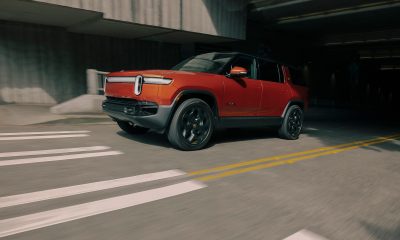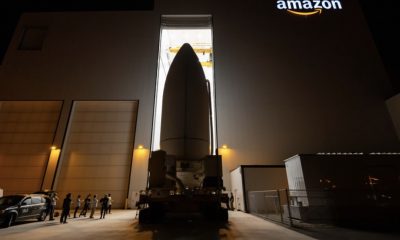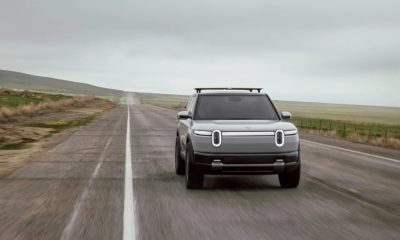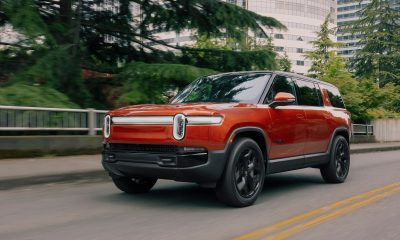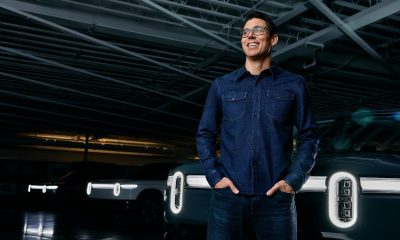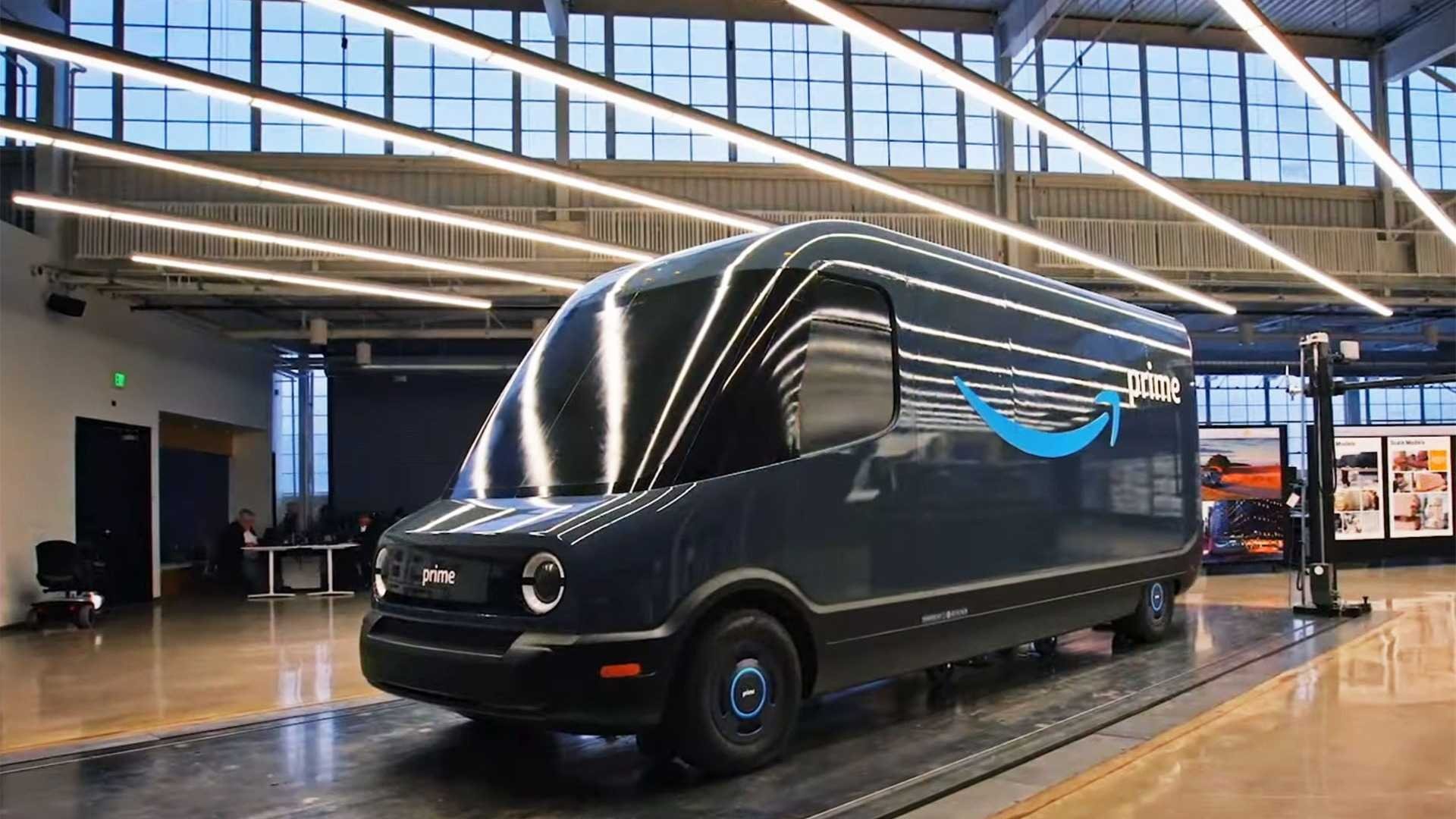

News
Rivian’s Amazon EV delivery van will drop packages in 100 cities by end of 2022
Amazon announced this morning that its Rivian Electric Delivery Vans (EDVs) will make deliveries in over 100 cities across the United States by the end of the year. Rivian plans to have EDVs operational in 100,000 U.S. cities by 2030.
Amazon and Rivian have collaborated on sustainable electric delivery vehicles since 2019, with pilot deliveries occurring over the past year. The pilot program accumulated over 90,000 miles of real-world testing and resulted in 430,000 package deliveries.
Rivian’s electric Amazon Delivery Van starts deliveries in San Francisco as testing continues
Finally, deliveries in production models of the Rivian EDV are set to expand to over 100 cities in the U.S. by the end of the year, including Baltimore, Chicago, Dallas, Kansas City, Nashville, Phoenix, San Diego, Seattle, and St. Louis, among other cities,” the e-commerce giant said. “This rollout is just the beginning of what is expected to be thousands of Amazon’s custom electric delivery vehicles in more than 100 cities by the end of this year—and 100,000 across the U.S. by 2030.”
Amazon ordered 100,000 Rivian EDVs in its initial order and has stood behind the EV startup in alignment with its Climate Pledge – a commitment to reach net-zero carbon across our operations by 2040. The Rivian vans, along with more sustainable packaging, helps Amazon decarbonize its last-mile logistics.
“Fighting the effects of climate change requires constant innovation and action, and Amazon is partnering with companies who share our passion for inventing new ways to minimize our impact on the environment. Rivian has been an excellent partner in that mission, and we’re excited to see our first custom electric delivery vehicles on the road,” Andy Jassy, CEO of Amazon, said. “Today marks a significant milestone in our Climate Pledge commitment. Rivian was one of the first companies Amazon invested in through the Climate Pledge Fund, and we’re just getting started on our journey to have 100,000 of Rivian’s vehicles on the road by 2030. And, in addition to being sustainable, these new vehicles are also great for drivers—they were designed with driver input and feedback along the way, and they’re among the safest and most comfortable delivery vehicles on the road today.”
Rivian builds its vehicles in Normal, Illinois. Along with the EDV, it builds the R1T, an all-electric truck, and R1S, an all-electric SUV.
“Today represents an important step, not just for Amazon and Rivian as partners, but also for transportation and the environment,” RJ Scaringe said, CEO of Rivian. “In 2019, Rivian and Amazon committed to fast-tracking a new type of delivery vehicle that would result in a significant reduction of carbon emissions. Thanks to our teams’ dedication, hard work and collaboration, and a shared commitment to make the world a better place for our kids’ kids, that vision is now being realized. To say this is an exciting moment is an understatement—we’re thrilled to see this partnership has kickstarted decarbonization projects across the logistics delivery industry.”
The Rivian EDV is also set to transition to an LFP battery pack as it fits commercial applications well and can be built at a cheaper cost. Along with that, our standard battery pack is leveraging LFP and LFP chemistry, and that chemistry not only allows us to offer that pack at a lower cost, but it really fits commercial applications well. And it’s first going to be launched in the commercial vehicle platform later this year, and then will make its way into our consumer vehicles by late 2023,” Scaringe said during the Q4 2021 Earnings Call.
Rivian hits EV Startup road bumps
Rivian has been a subject of normal EV startup road bumps in recent memory, becoming one of many companies to cut its employee headcount. Additionally, the company has struggled with margins and profitability early, which is expected. However, the automaker adjusted its 2022 production guidance earlier this year from 40,000 units to just 25,000. Rivian reaffirmed its commitment to this goal earlier in July.
The company’s financial situation is currently similar to what Tesla faced early in its production phases. CEO Elon Musk recently advised the company to cut costs in any way possible or it could face potential closure.
“That affordability threshold is very important,” Musk said in June. “It must both be a good value for money and be affordable in order to achieve good unit volumes. And where car companies can get, kind of, painted into a corner of doom is: If the cost of a car is so high that they have to raise the price of the car to the point where the price of the car is…and Rivian, I think, has this problem, you know, they’re going to need to fix it, or they’re in deep trouble…they raise the price to the point where only a very small number of people can afford the car, no matter how desirable it is. Then, at that point, if you cannot achieve a unit volume that covers your fixed costs, you’re screwed.”
I’d love to hear from you! If you have any comments, concerns, or questions, please email me at joey@teslarati.com. You can also reach me on Twitter @KlenderJoey, or if you have news tips, you can email us at tips@teslarati.com.
News
Tesla UK sales see 14% year-over-year rebound in June: SMMT data
The SMMT stated that Tesla sales grew 14% year-over-year to 7,719 units in June 2025.

Tesla’s sales in the United Kingdom rose in June, climbing 14% year-over-year to 7,719 units, as per data from the Society of Motor Manufacturers and Traders (SMMT). The spike in the company’s sales coincided with the first deliveries of the updated Model Y last month.
Model Y deliveries support Tesla’s UK recovery
Tesla’s June performance marked one of its strongest months in the UK so far this year, with new Model Y deliveries contributing significantly to the company’s momentum.
While the SMMT listed Tesla with 7,719 deliveries in June, independent data from New AutoMotive suggested that the electric vehicle maker registered 7,891 units during the month instead. However, year-to-date figures for Tesla remain 2% down compared to 2024, as per a report from Reuters.
While Tesla made a strong showing in June, rivals are also growing. Chinese automaker BYD saw UK sales rise nearly fourfold to 2,498 units, while Ford posted the highest EV growth among major automakers, with a more than fourfold increase in the first half of 2025.
Overall, the UK’s battery electric vehicle (BEV) demand surged 39% to to 47,354 units last month, helping push total new car sales in the UK to 191,316 units, up 6.7% from the same period in 2024.
EV adoption accelerates, but concerns linger
June marked the best month for UK car sales since 2019, though the SMMT cautioned that growth in the electric vehicle sector remains heavily dependent on discounting and support programs. Still, one in four new vehicle buyers in June chose a battery electric vehicle.
SMMT Chief Executive Mike Hawes noted that despite strong BEV demand, sales levels are still below regulatory targets. “Further growth in sales, and the sector will rely on increased and improved charging facilities to boost mainstream electric vehicle adoption,” Hawes stated.
Also taking effect this week was a new US-UK trade deal, which lowers tariffs on UK car exports to the United States from 27.5% to 10%. The agreement could benefit UK-based EV producers aiming to expand across the country.
News
Tesla Model 3 ranks as the safest new car in Europe for 2025, per Euro NCAP tests
Despite being on the market longer than many of its rivals, the Tesla Model 3 continues to set the bar for vehicle safety.

The Tesla Model 3 has been named the safest new car on sale in 2025, according to the latest results from the Euro NCAP. Among 20 newly tested vehicles, the Model 3 emerged at the top of the list, scoring an impressive 359 out of 400 possible points across all major safety categories.
Tesla Model 3’s safety systems
Despite being on the market longer than many of its rivals, the Tesla Model 3 continues to set the bar for vehicle safety. Under Euro NCAP’s stricter 2025 testing protocols, the electric sedan earned 90% for adult occupant protection, 93% for child occupant protection, 89% for pedestrian protection, and 87% for its Safety Assist systems.
The updated Model 3 received particular praise for its advanced driver assistance features, including Tesla’s autonomous emergency braking (AEB) system, which performed well across various test scenarios. Its Intelligent Speed Assistance and child presence detection system were cited as noteworthy features as well, as per a WhatCar report.
Other notable safety features include the Model 3’s pedestrian-friendly pop-up hood and robust crash protection for both front and side collisions. Euro NCAP also highlighted the Model 3’s ability to detect vulnerable road users during complex maneuvers, such as turning across oncoming traffic.
Euro NCAP’s Autopilot caution
While the Model 3’s safety scores were impressive across the board, Euro NCAP did raise concerns about driver expectations of Tesla’s Autopilot system. The organization warned that some owners may overestimate the system’s capabilities, potentially leading to misuse or inattention behind the wheel. Even so, the Model 3 remained the highest-scoring vehicle tested under Euro NCAP’s updated criteria this year.
The Euro NCAP’s concerns are also quite interesting because Tesla’s Full Self-Driving (FSD) Supervised, which is arguably the company’s most robust safety suite, is not allowed for public rollout in Europe yet. FSD Supervised would allow the Model 3 to navigate inner city streets with only minimal human supervision.
Other top scorers included the Volkswagen ID.7, Polestar 3, and Geely EX5, but none matched the Model 3’s total score or consistency across categories. A total of 14 out of 20 newly tested cars earned five stars, while several models, including the Kia EV3, MG ZS, and Renault 5, fell short of the top rating.
Elon Musk
Why Tesla’s Q3 could be one of its biggest quarters in history
Tesla could stand to benefit from the removal of the $7,500 EV tax credit at the end of Q3.

Tesla has gotten off to a slow start in 2025, as the first half of the year has not been one to remember from a delivery perspective.
However, Q3 could end up being one of the best the company has had in history, with the United States potentially being a major contributor to what might reverse a slow start to the year.
Earlier today, the United States’ House of Representatives officially passed President Trump’s “Big Beautiful Bill,” after it made its way through the Senate earlier this week. The bill will head to President Trump, as he looks to sign it before his July 4 deadline.
The Bill will effectively bring closure to the $7,500 EV tax credit, which will end on September 30, 2025. This means, over the next three months in the United States, those who are looking to buy an EV will have their last chance to take advantage of the credit. EVs will then be, for most people, $7,500 more expensive, in essence.
The tax credit is available to any single filer who makes under $150,000 per year, $225,000 a year to a head of household, and $300,000 to couples filing jointly.
Ending the tax credit was expected with the Trump administration, as his policies have leaned significantly toward reliance on fossil fuels, ending what he calls an “EV mandate.” He has used this phrase several times in disagreements with Tesla CEO Elon Musk.
Nevertheless, those who have been on the fence about buying a Tesla, or any EV, for that matter, will have some decisions to make in the next three months. While all companies will stand to benefit from this time crunch, Tesla could be the true winner because of its sheer volume.
If things are done correctly, meaning if Tesla can also offer incentives like 0% APR, special pricing on leasing or financing, or other advantages (like free Red, White, and Blue for a short period of time in celebration of Independence Day), it could see some real volume in sales this quarter.
You can now buy a Tesla in Red, White, and Blue for free until July 14 https://t.co/iAwhaRFOH0
— TESLARATI (@Teslarati) July 3, 2025
Tesla is just a shade under 721,000 deliveries for the year, so it’s on pace for roughly 1.4 million for 2025. This would be a decrease from the 1.8 million cars it delivered in each of the last two years. Traditionally, the second half of the year has produced Tesla’s strongest quarters. Its top three quarters in terms of deliveries are Q4 2024 with 495,570 vehicles, Q4 2023 with 484,507 vehicles, and Q3 2024 with 462,890 vehicles.
-

 Elon Musk4 days ago
Elon Musk4 days agoTesla investors will be shocked by Jim Cramer’s latest assessment
-

 News1 week ago
News1 week agoTesla Robotaxi’s biggest challenge seems to be this one thing
-

 Elon Musk2 weeks ago
Elon Musk2 weeks agoFirst Look at Tesla’s Robotaxi App: features, design, and more
-

 News2 weeks ago
News2 weeks agoSpaceX and Elon Musk share insights on Starship Ship 36’s RUD
-

 News2 weeks ago
News2 weeks agoWatch Tesla’s first driverless public Robotaxi rides in Texas
-

 News1 week ago
News1 week agoWatch the first true Tesla Robotaxi intervention by safety monitor
-

 News2 weeks ago
News2 weeks agoTesla has started rolling out initial round of Robotaxi invites
-

 Elon Musk2 weeks ago
Elon Musk2 weeks agoTesla to launch in India in July with vehicles already arriving: report


